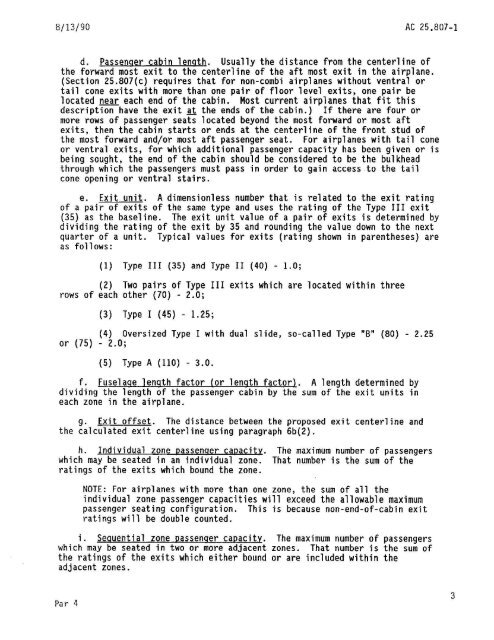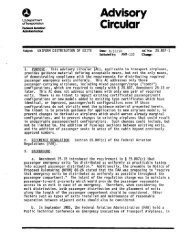Create successful ePaper yourself
Turn your PDF publications into a flip-book with our unique Google optimized e-Paper software.
8/13/90 <strong>AC</strong> <strong>25</strong>.<strong>807</strong>-1 <br />
d. Passenger cabin length. Usually the distance from the centerline of<br />
the forward most exit to the centerline of the aft most exit in the airplane.<br />
(Section <strong>25</strong>.<strong>807</strong>(c) requires that for non-combi airplanes without ventral or<br />
tail cone exits with more than one pair of floor level exits, one pair be<br />
located near each end of the cabin. Most current airplanes that fit this<br />
description have the exit at the ends of the cabin.) If there are four or<br />
more rows of passenger seats located beyond the most forward or most aft<br />
exits, then the cabin starts or ends at the centerline of the front stud of<br />
the most forward and/or most aft passenger seat. For airplanes with tail cone<br />
or ventral exits, for which additional passenger capacity has been given or is<br />
being sought, the end of the cabin should be considered to be the bulkhead<br />
through which the passengers must pass in order to gain access to the tail<br />
cone opening or ventral stairs.<br />
e. Exit unit. A dimensionless number that is related to the exit rating<br />
of a pair of exits of the same type and uses the rating of the Type III exit<br />
(35) as the baseline. The exit unit value of a pair of exits is determined by<br />
dividing the rating of the exit by 35 and rounding the value down to the next<br />
quarter of a unit. Typical values for exits (rating shown in parentheses) are<br />
as follows:<br />
(1) Type III (35) and Type II (40) - 1.0;<br />
(2) Two pairs of Type III exits which are located within three<br />
rows of each other (70) - 2.0;<br />
(3) Type I (45) - 1.<strong>25</strong>;<br />
11<br />
(4) Oversized Type I with dual slide, so-called Type 8 11<br />
(80) - 2.<strong>25</strong><br />
or (75) - 2.0;<br />
(5) Type A (110) - 3.0.<br />
f. Fuselage length factor (or length factor). A length determined by<br />
dividing the length of the passenger cabin by the sum of the exit units in<br />
each zone in the airplane.<br />
g. Exit offset. The distance between the proposed exit centerline and<br />
the calculated exit centerline using paragraph 6b(2).<br />
h. Individual zone passenger capacity. The maximum number of passengers<br />
which may be seated in an individual zone. That number is the sum of the<br />
ratings of the exits which bound the zone.<br />
NOTE: For airplanes with more than one zone, the sum of all the<br />
individual zone passenger capacities will exceed the allowable maximum<br />
passenger seating configuration. This is because non-end-of-cabin exit<br />
ratings will be double counted.<br />
i. Sequential zone passenger capacity. The maximum number of passengers<br />
which may be seated in two or more adjacent zones. That number is the sum of<br />
the ratings of the exits which either bound or are included within the<br />
adjacent zones.<br />
Par 4<br />
3



